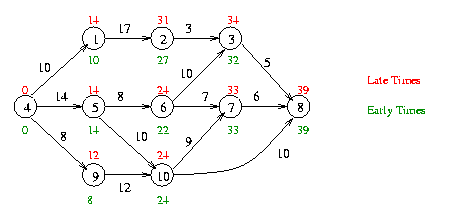

The values are computed as follows:
For each node, compute for each predecessor the sum of its early time and the weight of the arc joining the nodes. The largest of these sums is the early time of the node under consideration. This follows the notion that you do not reach a node until you have completed all the tasks that must come before it.
For instance, node 8 sees the sums 32 + 5 = 37, 33 + 6 = 39, and 24 + 10 = 34. The early time of node 8 is 39.
For each node, compute for each successor the difference of its late time and the weight of the arc joining the nodes. The smallest of these sums is the early time of the node under consideration. This follows the notion that you must reach a node soon enough not to delay any of its successors.
For instance, node 5 sees 24 - 8 = 16 and 24 - 10 = 14. Its early time is 14.